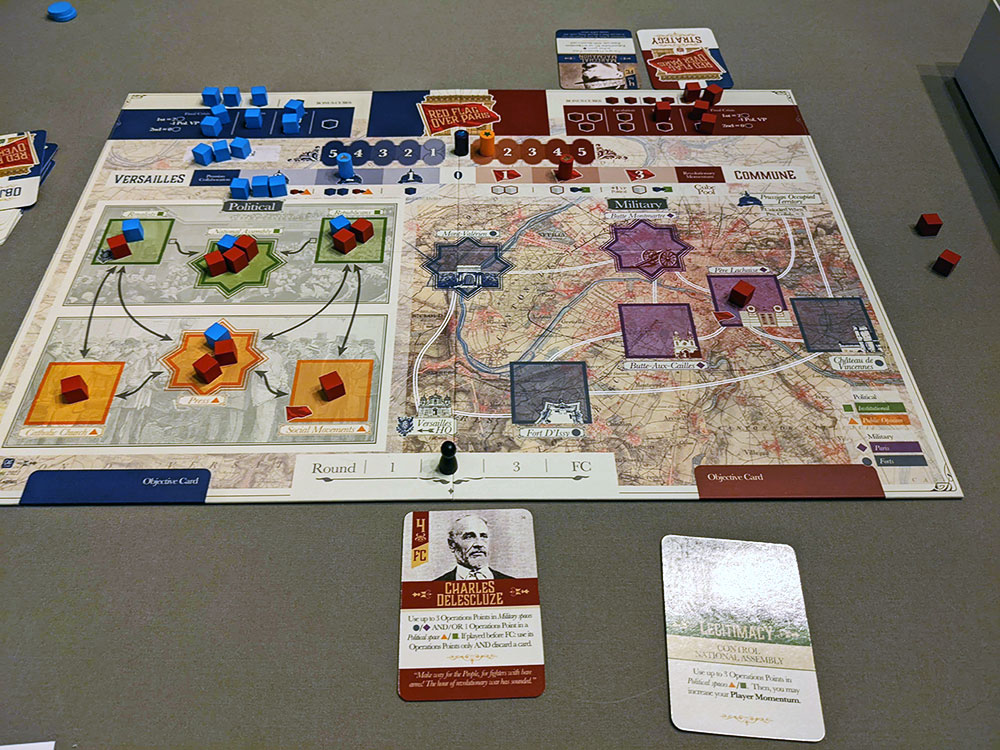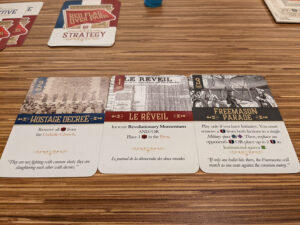 If you were to read my last few reviews, you’d be sure I was a two-player game fanboy. You might also gather that I’m a GMT-head, a champion of the card-driven war game. I actually am neither of those things. It’s pure coincidence that my last three reviews were for two-player only games, and my last two were card-driven war games. What drew me to Red Flag Over Paris, a two-player, card-driven game designed by Frédéric Serval and published by GMT, was the historical setting of the Paris Commune and its fast playtime, which clocks in at about 30 minutes.
If you were to read my last few reviews, you’d be sure I was a two-player game fanboy. You might also gather that I’m a GMT-head, a champion of the card-driven war game. I actually am neither of those things. It’s pure coincidence that my last three reviews were for two-player only games, and my last two were card-driven war games. What drew me to Red Flag Over Paris, a two-player, card-driven game designed by Frédéric Serval and published by GMT, was the historical setting of the Paris Commune and its fast playtime, which clocks in at about 30 minutes.
The Paris Commune was one of the most uniquely interesting moments during one of the most uniquely interesting centuries in French and World History. France went from being a revolutionary republic to being an empire, then back to being a monarchy, then a different monarchy, then a republic again, then another “empire” (quoted because it was a bit of a joke as empires go), and finally, another republic, which brings us to 1871, the year in which the events of Red Flag Over Paris transpire. If your head is reeling from this list of governmental upheaval, imagine how the people of Paris felt!
Gameplay Overview:
Similar to other card-driven games such as Twilight Struggle or Paths of Glory, Red Flag over Paris offers two players a chance to take on the roles of opposing forces in a multi-faceted struggle for power. One player takes on the role of the capitulatory Versailles government, the leaders who surrendered to the Prussians at the conclusion of the Franco-Prussian War, and the other player assumes the role of the people of Paris, consisting of the rebellious troops of the National Guard and the socialist radicals who claimed power for themselves in the wake of France’s embarrassing defeat at the hands of the Prussians. The game is played over three rounds, or possibly less if certain conditions are met.

The conflict in Red Flag Over Paris is not simply fought among the barricades and forts of Paris. Political maneuvering was just as important, and so the game has four areas wherein conflicts are resolved: Two political (“Institutional” and “Public Opinion”) and two military (“Paris” and “Forts”). These are called Crisis Dimensions and control of these is scored every round, giving the player a political point or a military point, depending on what Crisis Dimension they control.
Each round consists of three actions per player. As with other card-driven war games, each action mostly consists of playing a card, either for its event or for its Operations Points, which allow players to add or remove cubes from the board. The cubes dictate control, and while it’s easy to remove your opponent’s influence in the political sphere, it is harder to do so in the military sphere (there were, after all, countrymen who were not terribly inspired to kill one another).

While each player plays only three cards each round, they do draw four cards at the beginning of a round and must select one of their cards to squirrel away for a final round called The Final Crisis. This is meant to represent the final historical conflict of the Paris Commune, which was called The Bloody Week, and consisted of, well, a bloody reprisal against the commune leaders.
After three rounds (or earlier if certain conditions are met), players must play three of their potentially four remaining cards that were held back for The Final Crisis and are required to play them for the events listed, not the Operations Points value. After the Final Crisis, if the Commune player has more political points than the Versailles player has military points, they win outright. If the Versailles player has more military points than the Commune player has political points, they win. In the (very common) case of a tie, there are four tiebreaker conditions. Whoever can claim more of them wins.

Game Experience:
It’s important to acknowledge the type of game this is. This is a fast, card-driven war game. Much like The Shores of Tripoli, this game is easily played in under an hour (and with Red Flag, easily played in 30 minutes). That’s a pretty crucial point of appeal, as many of the games in the genre are traditionally in the two- to three-hour range, or even more. This can be played during one’s lunch break and never really overstays its welcome. Hell, it’s literally part of GMT’s “Lunchtime Series” of games, so it’s baked into their marketing.

The thematics are also top notch. While it’s easy to play a game like Red Flag and totally ignore its flavor text, there are some actual game mechanics that lean into thematic elements, which enhances the experience of the game. The Momentum Track is a great example of this. This track serves a different purpose for each player. For the Commune Player, it is called the “Revolutionary Momentum Track,” and is meant to represent the increasing radicalization of the Commune members, while also giving that player a much-needed Cube Bank where cubes removed from the board can be returned to, lest they be removed entirely from the game.
The Versailles player does not have this issue. They already have a limitless cube bank, representing the Versailles government’s significant edge over the Communards on resources. But as the Commune player advances further on the Revolutionary Momentum track, the public’s reaction to their increased radicalization can be mixed, and so the Versailles player gets to place a cube in the Public Opinion or Institutional Crisis Dimensions as a response to this increased radicalization.

Similarly, the Versailles player’s momentum track, called the “Prussian Collaboration Track,” is also deeply thematic. As that player progresses along it, it receives more cubes, representing help from the Prussians, who — while they have just defeated France in war — are willing to help France’s legitimate government get the unruly masses of Paris under control. As you can imagine, the people of Paris don’t love this collaboration with their very recent enemy, so the deeper down that path the Versailles player goes, the more cubes the Commune player may place in the Public Opinion or Institutional Crisis Dimensions.
The player aids are mostly good, but one very confusing element is the omission of the Pivotal Space bonuses. During my first few plays, I was constantly reaching for the rulebook to check my options, when it could have very easily been included in the otherwise handy player aid. Additionally, rulebook is sadly a bit lacking. The decision by GMT to split their reference materials up into a “rulebook” and a “playbook” is ultimately a bad move. Normally, rulebooks feature illustrations of the game board and components, particularly where the game setup is described. This is not done in the rulebook but is sort of included in the playbook.

The playbook walks players through the first few rounds of an example game, as well as the Final Crisis, both for a two-player game and for solo mode, and also includes a number of pages devoted to historical background on the Paris Commune. I think all of this could have been easily combined into one booklet, or simply had a separate booklet specifically for the historical background material, and kept the rules, examples, and illustrations together in a rulebook.
The one element that did potentially derail the game at times was simply the luck of the draw. A player could potentially draw all cards that belong to the other player’s faction, meaning they can pretty much only use them for their Operations Points. This can be a very frustrating start and can ultimately lead to a hole that is very hard to dig out of. That said, because the game is so fast, it never really felt like that big of a problem. The option to set it back up for another game was always in play.
Final Thoughts:
Overall, Red Flag Over Paris is an excellent card-driven war game from GMT, and the speed at which it plays makes it perfect for those moments in a game night where two players need that 30-minute filler between larger games but want something that has a little heft. Furthermore, the game’s setting is appealing to history nerds like me, and the game does a good job folding the theme into the mechanics. The game’s margin of victory is always razor thin and often comes down to the Final Crisis, keeping each play engaging until the end. Its rulebook and player aid issues are mildly frustrating, but once players familiarize themselves with the mechanics, it’s flows fairly seamlessly.
Final Score: 3.5 Stars – A solid addition to GMT’s Lunchtime Series, giving two players the feel of a Twilight Struggle card-driven war game in the space of 30 minutes and delivering on a very serviceable marriage of theme and mechanics.
 Hits:
Hits:
• Short playtime
• Simple ruleset for a card-driven wargame
• Thoughtful presentation of theme
Misses:
• Order in which cards are drawn greatly impacts start
• Cards could be higher quality
• Rulebook is confusingly put together





















